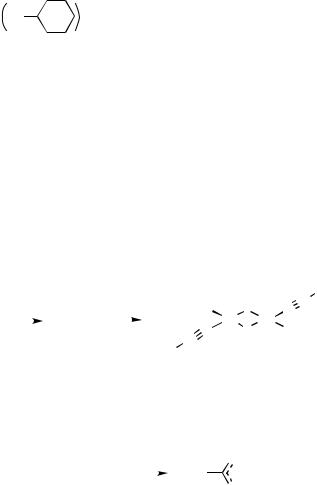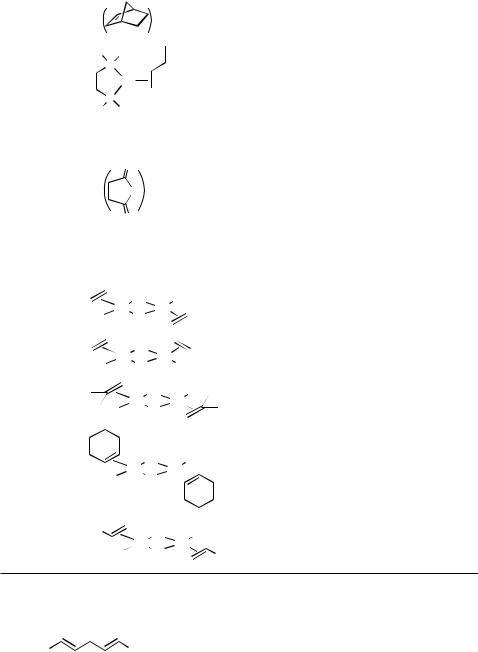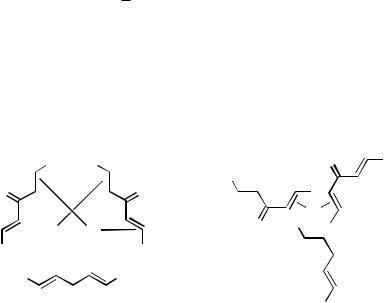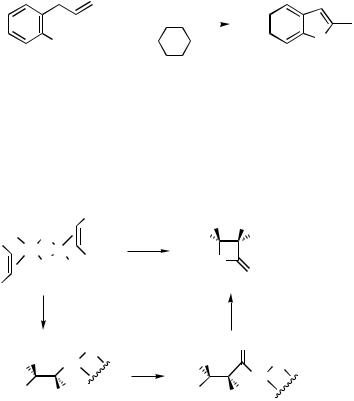

Csp3-Pd, Csp2-Pd, Csp-Pd
II.3.2 Stoichiometric Synthesis and Some
Notable Properties of Organopalladium
Compounds of Pd(0) and Pd(II)
DANIÈLE CHOUEIRY
A. INTRODUCTION
As discussed in Sect. I.2, palladium complexes of general formula PdLn can react according to well-defined reaction patterns that lead to organopalladium complexes through C — Pd bond formation. These general patterns were largely discussed in Sect. II.3.1. While these principles are most often used to generate in situ organopalladium species, under catalytic conditions, they have also been applied to the preparation of discrete organopalladium entities in a stoichiometric way. Isolation of organopalladium complexes is important not only in the preparation of organopalladium catalysts, but also for mechanistic investigations. Indeed, it is through the understanding of both their reactivity and the rules governing their formation that the discovery of new catalytic reactions via organopalladium complexes can be significantly facilitated.
Palladium forms complexes with a variety of carbon ligands. The carbon ligand may be neutral or charged, and sp3, sp2, or sp hybridized. Pd complexes of neutral carbon ligands, such as CO and alkenes, are typically generated by complexation reactions, while oxidative addition, hydro-, carbo-, and heteropalladation reactions, and transmetallation provide major routes to the organopalladium complexes containg a C — Pd bond. The reactivity of organopalladium complexes is also indicated by the general patterns (Sect. II.3.1). While some of these patterns, such as carbometallation and migratory insertion, result in new organopalladium species, some others, such as reductive elimination or nucleophilic attack on ligands, result in the destruction of organopalladium species.
B. PALLADIUM COMPLEXES CONTAINING
NEUTRAL CARBON LIGANDS ONLY
Palladium forms complexes with a variety of neutral carbon ligands. While some of them, such as CO and isonitriles, bind to palladium in a - or -fashion, others, such as alkenes, dienes, and alkynes, form -complexes.
Handbook of Organopalladium Chemistry for Organic Synthesis, Edited by Ei-ichi Negishi ISBN 0-471-31506-0 © 2002 John Wiley & Sons, Inc.
147

148 |
II Pd-COMPOUNDS: STOICHIOMETRIC PREPARATION |
B.i. - and -Carbon Ligands: Carbonyl and Isonitrile Complexes
The chemistry of palladium – carbonyl complexes has experienced extensive recent developments due to an increased interest in the role of palladium in surface catalysis especially in automobile exhaust catalysts. Palladium – carbonyl complexes are nevertheless still relatively rare, which is probably due to their relative instability in comparision with that of Ni complexes. The homoleptic Pd(CO)4 only exists at low temperatures ( 80 K) in noble gas or CO matrices, in sharp contrast with isoleptic Ni(CO)4, which is stable at ambient temperature. Table 1 compiles some of the known and representative carbonyl complexes of palladium.
In cases of dinuclear Pd – carbonyl complexes, the carbonyl ligand can be linear [i.e., Pd( -CO)] or bridging [i.e., Pd2( -CO)]. Actually, the great majority of dinuclear Pd carbonyls have carbonyl-bridged structures. However, most of these complexes are Pd(I) complexes and will not be covered in this section. An exception is the Pd(II) complex, Pd2(CO)2Cl4, in which the CO ligands are terminal.
Palladium – carbonyl complexes are typically formed from PdX2 (X Cl, Br, or I) and CO. For example, Pd2(CO)2Cl4 is obtained by high-pressure carbonylation of PdCl2. Similarly, the anionic M[Pd(CO)X3] are obtained from carbonylation of PdX2 or M2(Pd2X6). While the iodide is relatively unstable, the chloride and bromide could be characterized by X-ray crystallography.[4]
Alternatively, CO can displace a variety of ligands from palladium and Pd – CO complexes have been prepared from Pd – nitrile and even Pd – phosphine complexes. For instance, Pd(CO)2Cl2 has been obtained via ligand displacement of Cl2Pd(PhCN)2 with CO. In cases of Pd(0) complexes, the starting materials can be either Pd(0) species, such as Pd(PPh3)4, or Pd(II) species, such as Cl2Pd(PPh3)2. In the latter cases, the use of added reducing agents may be desirable or necessary, as in the preparation of Pd(CO)(PPh3)3 (Scheme 1).[10] Alternatively, this same complex can be obtained from Pd(PPh3)4 and CO
TABLE 1. Palladium–Carbonyl Complexes
Carbon |
|
|
|
|
References |
Number a |
Pd – Carbonyl Complex |
Comments |
for Preparation |
||
|
|
|
|
|
|
MONOMERS |
|
|
|
|
|
1 |
M[Pd(CO)Cl3] |
|
M Et2H2N, Bu4N |
[1],[2] |
|
|
M[Pd(CO)Br3] |
|
M K, Bu4N |
[1],[3] |
|
|
M[Pd(CO)I3] |
|
M Bu4N; readily loses CO |
[4] |
|
|
M[Pd(CO)Cl(SnCl3)2] |
M Et4N |
[5] |
||
2 |
Pd(CO)2Cl2 |
|
|
[6] |
|
4 |
Pd(CO)4 |
|
|
Only by matrix isolation |
[7] |
13 |
[Pd(CO)(PEt3)2Cl]X |
X BF4; readily loses CO |
[8] |
||
21 |
Pd[CO)3(PPh3) |
|
Only under CO pressure |
[9] |
|
55 |
Pd(CO)(PPh3)3 |
|
|
[10],[11] |
|
DIMERS |
OC |
Cl |
Cl |
|
|
Pd |
|
Pd |
|
|
|
|
Cl |
|
|
||
1 |
Cl |
CO |
|
[2] |
|
|
|
|
|
||
|
OC |
Br |
Br |
|
[4] |
|
Pd |
|
Pd |
|
|
|
Br |
|
|
||
|
Br |
CO |
|
|
|
a Number of C atoms in a monomer unit.

II.3.2 STOICHIOMETRIC SYNTHESIS AND SOME NOTABLE PROPERTIES |
149 |
(Scheme 1).[11] Palladium – carbonyl complexes can themselves be the source of other carbonyl complexes. For example, (Et2H2N)[Pd(CO)Cl3] can be obtained from Pd2Cl4(CO)2 and Et2H2NCl.[2]
Pd(PPh3)2Cl2 |
+ |
CO |
NaBH4, PPh3 |
|||
|
Pd(CO)(PPh3)3 |
|||||
[10] |
||||||
|
|
|
|
|
||
Pd(PPh3)4 |
+ |
CO |
|
|
Pd(CO)(PPh3)3 |
|
|
[11] |
|||||
|
|
|
|
|
||
|
|
|
|
Scheme 1 |
||
The most interesting feature of the reactivity of Pd – CO complexes is their migratory insertion reaction that takes place in cases where the Pd – CO complex simultaneously contains an additional C — Pd bond. This migratory insertion of CO leads to the formation of acyl – Pd complexes. Indeed, Pd(0) complexes of CO, such as Pd(CO)(PPh3)3, can react with methyl iodide, allyl chloride, and vinyl chloride, to give the corresponding acyl – Pd complexes (Scheme 2).[10] This transformation can be explained in terms of an oxidative addition – migratory insertion sequence (Scheme 2). Acyl – Pd complexes will be discussed in greater detail in Sect. C.ii.
|
|
|
|
|
|
|
MeI |
O |
|
PPh3 |
||||||||||||||
|
|
|
|
|
|
|
|
|
|
|||||||||||||||
Pd(CO)(PPh3)3 |
|
|
|
|
|
|
|
|
|
|
|
|
Me |
|
|
C |
|
Pd I |
||||||
|
|
|
|
|
|
|
|
|
|
|
|
|
||||||||||||
|
|
|
|
|
|
|
|
|
|
|
|
|
|
|
|
|
|
|
|
|
|
|
|
PPh3 |
oxidative |
|
|
|
|
|
|
|
|
|
|
|
|
|
|
|
|
|
|
|
|
|
|
migratory |
|
|
|
|
|
|
|
|
|
|
|
|
|
|
|
|
|
|
|
|
|
|
|
|||
|
|
PPh3 |
|
|
|
|
|
|
|
CO |
|
|
|
|
|
|
|
|||||||
addition |
|
|
|
|
|
|
|
|
|
|
|
|
|
|
|
insertion |
||||||||
|
|
|
Me |
|
Pd I |
|
|
|
|
Me |
|
|
Pd I |
|
|
|
|
|
|
|||||
|
|
|
|
|
|
|
|
|
||||||||||||||||
|
|
|
|
|
PPh3 |
|
|
|
|
|
|
|
PPh3 |
|
|
|
|
|
|
|
|
|
|
|
Scheme 2
This reaction profile, also called carbonylation, governs the reactivity of Pd – carbonyl complexes. Anionic M[Pd(CO)I3], for instance, catalyzes the reductive carbonylation of esters.[12] On the other hand, Pd(CO)(PPh3)3 was reported to catalyze the carboxymethylation of organic halides[13] and the cyclocarbonylation of cinnamyl halides.[14] However, the Pd – CO complexes are most often generated in situ from preformed alkyl – palladium complexes and CO under stoichiometric[15] or catalytic conditions, for example, in the copolymerization of alkenes and CO.[16] Decarbonylation reactions also involve the intermediacy of Pd – CO complexes. In this case, migratory deinsertion (Sect. II.3.1), that is, the microscopic reversal of the migratory insertion, takes place.
Closely related to the palladium – carbonyl complexes are the palladium – isonitrile complexes. Isonitriles are better -donors than the isoelectronic CO and are consequently better ligands for Pd than CO. Their Pd complexes are indeed more stable than the corresponding CO complexes. Isonitrile – palladium complexes are usually prepared from PdX2 (X Cl, Br, I), or their derivatives, for example, Na2PdCl4, and Cl2Pd(CH3CN)2, via ligand exchange. Occasionally, organopalladium complexes such as ( 5-C5H5)

150 |
II |
Pd-COMPOUNDS: STOICHIOMETRIC PREPARATION |
|
||||
|
TABLE 2. Palladium–Isonitrile Complexes |
|
|
||||
|
|
|
|
|
|
|
|
|
Carbon |
|
|
|
|
References |
|
|
Number |
|
Pd – Isonitrile Complex |
Comments |
for Preparation |
||
|
|
|
|
|
|
|
|
8 |
|
Pd[(CNMe)4]X2 |
|
X BF4, PF6 |
[17],[18] |
||
10 |
|
Pd(CNBu-t)2 |
|
|
[19] |
||
|
|
|
|
Pd(CNBu-t)2Cl2 |
|
cis |
[20] |
|
|
|
|
Pd(CNBu-t)2I2 |
|
trans |
[19] |
|
|
|
|
Pd(CNBu-t)2O2 |
|
|
[19] |
14 |
|
Pd CN |
X2 |
X Cl, I; cis |
[21] |
||
|
|
|
|
|
|
||
|
|
|
|
|
2 |
|
|
|
|
|
|
|
|
|
|
( 3-C3H5)Pd (Sect. |
C.i) serve as precursors to Pd – isonitrile complexes, for |
example, |
Pd(CNR)2. Finally, |
Pd – isonitrile complexes can also serve as precursors |
to other |
Pd – isonitrile complexes. An example is provided by the preparation of Pd(CNBu-t)2O2 from Pd(CNBu-t)2. Table 2 lists some representative Pd – isonitrile complexes.
Like Pd – CO complexes, Pd – isonitrile complexes can undergo oxidative addition into carbon – halide bonds, and then subsequent migratory insertion, as exemplified in
Scheme 3.[22]
Another interesting reaction of Pd( I I ) – isonitrile complexes is that with protic compounds to produce palladium – carbene complexes (Scheme 4).[23]
Bu-t
|
|
|
|
|
|
|
|
|
|
|
|
|
|
|
|
|
Bu-t |
|
|
|
|
|
|
|
|
|
|
|
|
|
|
|
|
|
|
|
|
|
|
|
|
|
|
|
|
||||
|
|
|
|
N |
|
|
|
|
|
|
|
|
|
|
|
|
|
|
|
|
|
|||
|
|
|
|
|
|
|
|
|
|
|
|
|
|
|
|
|
|
|
|
|
||||
|
|
|
|
|
|
|
|
|
|
|
|
|
N |
|
|
|
|
|
Bu-t |
|||||
|
|
|
|
|
|
|
|
|
|
|
|
|
|
|
|
|
|
|
|
|
|
|||
|
|
|
|
|
C |
|
|
|
|
|
|
|
|
|
|
|
|
|
|
|
N |
|||
|
|
|
|
|
|
|
|
|
|
|
|
|
|
|
|
|
|
|
|
|||||
|
|
|
|
|
|
|
|
|
|
|
|
Me |
|
C |
|
I |
|
|
||||||
|
|
|
|
|
|
|
|
|
|
|
|
|
|
1 |
|
|
C |
|||||||
|
|
|
|
|
|
|
|
|
|
|
|
|
|
|
||||||||||
|
|
|
|
|
|
|
|
|
|
|
|
|
|
|||||||||||
Pd(CNBu-t)2 + MeI |
|
Me |
|
Pd |
|
I |
|
|
|
|
|
|
|
|
|
Pd |
Pd |
|||||||
|
|
|
|
|
|
|
2 |
|
|
|
|
|||||||||||||
|
|
|
|
|
|
|
|
|
|
|
|
|
|
|
|
|
C |
|
I |
C |
|
Me |
||
|
|
|
|
|
C |
|
|
|
|
|
|
|
|
|||||||||||
|
|
|
|
|
|
|
|
|
|
|
|
N |
|
|
|
|
|
|
||||||
|
|
|
|
|
|
|
|
|
|
|
|
|
|
N |
||||||||||
|
|
|
|
|
|
|
|
|
|
|
|
|
|
t-Bu |
|
|
||||||||
|
|
|
|
N |
|
|
|
|
|
|
|
|
||||||||||||
|
|
|
|
|
|
|
|
|
|
|
|
|
|
|
|
|
|
|
|
|
||||
|
|
|
|
|
|
|
|
|
|
|
|
|
|
|
|
|
Bu-t |
|||||||
|
|
|
|
|
|
|
|
|
|
|
|
|
|
|
|
|
|
|
|
|
||||
|
|
|
|
|
Bu-t |
|
|
|
|
|
|
|
||||||||||||
|
|
|
|
|
|
|
|
|
|
|
|
|
|
|
|
|||||||||
|
|
|
|
|
|
|
|
Scheme 3 |
|
|
|
|
|
|
|
|
|
|
|
|||||
|
|
|
|
|
|
|
|
|
|
|
|
|
|
|
|
|
|
|
R |
|
|
|
|
|
|
|
|
|
|
|
|
|
|
|
|
|
|
|
|
|
|
|
|
|
|
|
|
|
|
|
|
|
|
|
|
|
|
|
|
|
|
|
|
|
|
|
|
|
NH |
|
|
|
|
|
LnPd=C=NR |
+ |
|
|
HY |
|
|
LnPd |
Y |
|
|
|
|
||||||||||||
|
|
|
|
|
|
|
|
|||||||||||||||||
|
|
HY = OR′, NR′R′′ |
|
|
|
|
|
|
|
|
|
|||||||||||||
|
|
|
|
|
|
|
|
|
|
|
|
|
||||||||||||
Scheme 4
B.ii. 2-, 4-Carbon Ligands ( -Complexes): Alkenes, Dienes,
and Alkynes Complexes
Many examples of Pd – alkene, Pd – diene, and Pd – alkyne complexes are known for both Pd(0) and Pd(II) oxidation states. Representative examples are given in Tables 3, 4, and 5.

|
II.3.2 STOICHIOMETRIC SYNTHESIS AND SOME NOTABLE PROPERTIES |
151 |
||
TABLE 3. Palladium–Monoene -Complexes |
|
|
|
|
|
|
|
|
|
Carbon |
|
|
References |
|
Number a |
Pd – Monoene Complex |
Comments |
for Preparation |
|
MONOMERS
2 |
M[Pd(H2CRCH2)Cl3] |
|||
4 |
Pd(H2CRCH2)2Cl2 |
|||
6 |
Pd(H2CRCH2)3 |
|
||
21 |
Pd |
|
||
|
|
|||
|
3 |
|
|
|
|
Cy Cy |
|
c |
|
|
|
|||
|
|
|
||
|
P |
|
|
|
30 |
Pd |
|
|
|
|
|
|
|
|
P
Cy Cy
38Pd(H2CRCH2)(PPh3)2 Pd(H2CRCH2)(PCy3)2
O
40 |
Pd |
O (PPh3)2 |
|
|
O |
51 |
Pd(dba)3d |
|
96 |
Pd( 2-C60)(PPh3)2 |
|
M Bu4N; unstable at r.t.b |
[24] |
Stable under C2H4 |
[25] |
Stable under C2H4 |
[26] |
|
[26] |
Stable at 0 C |
[27] |
Air-sensitive |
[28] |
Air-sensitive |
[28] |
Air-stable |
[29] |
Unstable |
[30] |
|
[31] |
DIMERS
2 |
Pd |
Cl |
Cl |
trans |
Pd |
|
|||
|
Cl |
Cl |
|
|
|
Pd |
Cl |
|
cis |
|
Pd |
|
||
|
Cl |
Cl |
Cl |
|
4 |
|
Cl |
Cl |
|
Cl |
Pd |
Pd |
|
|
|
Cl |
|
|
|
|
|
Cl |
Cl |
|
6 |
Pd |
Pd |
|
|
Cl |
Cl |
|
|
|
8 |
Ph |
Cl |
Cl |
|
|
|
|||
Cl |
Pd |
Pd |
|
|
|
Cl |
|
Ph |
|
|
|
|
|
|
aNumber of C atoms in a monomer unit.
br.t. room temperature.
cCy Cyclohexyl.
|
O |
||
d dba Ph |
|
|
Ph |
|
|
||
[32],[33]
[34]
[32]
[32]
[32]

152 |
II Pd-COMPOUNDS: STOICHIOMETRIC PREPARATION |
|
||
|
TABLE 4. Palladium–Diene and Palladium–Polyene -Complexes |
|
||
|
|
|
|
|
|
Carbon |
|
|
References |
|
Number |
Pd Complex |
Comments |
for Preparation |
|
|
|
|
|
DIENE COMPLEXES
6 |
|
PdCl2 |
7 |
|
PdX2 |
|
|
|
8 |
|
a |
|
||
|
|
PdX2 |


 PdCl2
PdCl2
|
[35] |
X Cl, Br |
[36] |
X Cl, Br, I; commercially |
[37],[38] |
available for X Cl |
|
Air-sensitive |
[39] |
16 |
|
|
Pd |
|
|
|
|
|
|
|
|
34 |
Pd(dba)2d |
|
|
||
51 |
Pd2(dba)3d |
|
|
||
|
|
Ph |
Ph |
||
56 |
Pd |
|
|
||
|
|
Ph |
Ph |
||
b |
[26] |
Stable below r.t.c |
|
|
[40] |
|
[41] |
|
[42] |
2
POLYENE COMPLEXES |
|
|
60 |
Pd(C60) |
[43] |
aPd(1,5-cyclooctadiene)Cl2 or Pd(1,5-cod)Cl2.
bPd(1,5-cod)2.
cr.t. room temperature.
O
d dba Ph |
Ph |
Alkene complexes of Pd(0) can be obtained from either Pd(0) or Pd(II) precursors. For example, Pd(H2C"CH2)3 (Table 3) is obtained by the condensation of Pd atoms with ethylene, or via ligand displacement from Pd(1,5-cod)2 (Table 4),[26] which, in turn, is obtained by the reduction of Pd(1,5-cod)Cl2 in the presence of 1,5-cyclooctadiene.[26]
Likewise, mixed alkene/phosphine Pd(0) complexes, for example, Pd(alkene)(PR3)2, can be obtained either by the reduction of a Pd(II) species, such as Pd(acac)2 or Pd(OAc)2, in the presence of the desired alkene and phosphine,[28] or by the reaction of Pd(PR3)4 with the desired alkene.[29] Dienes and polyenes can also serve as ligands in such complexes. In these cases, however, they act as monoenes, for example, Pd( 2-1,3- butadiene)(Cy2PC2H4PCy2) and Pd( 2-C60)(PPh3)2, and are consequently classified in Table 3. Alkene complexes of Pd(0) are usually less stable than their Ni or Pt analogs, but electron-withdrawing groups in alkenes stabilize the resulting complexes, for example, Pd(maleic anhydride)(PPh3)2.[29] Alkynes containing electron-withdrawing groups behave

|
II.3.2 STOICHIOMETRIC SYNTHESIS AND SOME NOTABLE PROPERTIES |
153 |
|
TABLE 5. Palladium–Alkyne -Complexes |
|
|
|
|
|
|
|
Carbon |
|
References |
|
Number a |
Pd Complex |
for Preparation |
|
|
|
|
|
MONOMERS |
|
|
|
20 |
Pd(CF3C#CCF3)(PPhMe2)2 |
[44] |
|
32 |
Pd(MeOOCC#CCOOMe) (Cy2PCH2CH2PCy2) |
[27] |
|
40 |
Pd(CF3C#CCF3) (PPh3)2 |
[44] |
|
|
Pd(PhC#CPh)2 (C6F5)2 |
[45] |
|
42 |
Pd(MeOOCC#CCOOMe) (PPh3)2 |
[44] |
|
DIMERS |
|
|
|
10 |
[Pd(t-BuC#CBu-t)Cl2]2 |
[46] |
|
|
|
|
|
a Number of C atoms in a monomer unit.
similarly to form relatively stable mixed alkyne/phosphine – Pd complexes and are prepared in manners similar to those of their alkenes analogs (Table 5).
Some of the synthetically important Pd – alkene -complexes include Pd(dba)2 and Pd2(dba)3, which are stable to air and commercially available. The ease of displacement of the dba ligands by a variety of ligands including phosphines is at the origin of their extensive use as Pd(0) precursors, for both stoichiometric preparation (Scheme 5)[43] and in situ generation of Pd(0) species.[47],[48] The role of dba in the reactions of Pd(0) complexes in situ generated from Pd(dba)2 and phosphines has been thoroughly investigated in the past few years.[49]
12 Pd2(dba)3 + C60  Pd(C60)
Pd(C60)
Scheme 5
It is worth noting that Pd(dba)2 and Pd2(dba)3 are structurally closely related complexes in which the dba act as 4 ligands (Scheme 6). Recrystallization of Pd(dba)2, which actually is better represented by [Pd2(dba)3](dba), from chloroform, benzene, or toluene leads to [Pd2(dba)3](solvent).[41] On the other hand, Pd(dba)3 is obtained by the addition of an excess of dba to Pd(dba)2. In this case, dba acts as an 2 ligand (Scheme 6).[30]
|
|
|
|
|
Ph |
Ph |
Ph |
|
|
|
O |
Ph |
||||||
O |
|
|
|
|
|
|
|
|
|
Ph |
|
|||||||
|
|
|
|
|
|
|
|
|
|
|||||||||
|
|
|
|
|
|
|
|
O |
|
|
|
|
||||||
|
|
|
|
|
|
|
||||||||||||
|
|
|
|
|
|
|
|
|
|
|
|
|||||||
|
|
|
|
|
||||||||||||||
|
|
|
|
|
|
|
|
|
|
Pd2(dba)3 |
|
Pd |
Pd(dba)3 |
|||||
|
|
|
|
Pd |
Pd |
|
O |
Ph |
Ph |
|
||||||||
|
|
|
|
|
|
|
|
|||||||||||
|
|
|
|
|
|
|
|
|
|
|
|
|
||||||
|
|
|
|
|
|
|
|
|
|
|
|
|||||||
Ph |
|
|
|
Ph |
|
|
|
|
|
O |
||||||||
Ph |
|
|
|
|
|
Ph |
|
|
|
|
|
|||||||
|
|
|
|
|
|
|
Ph |
|||||||||||
|
|
|
|
|
|
|||||||||||||
|
|
|
|
|
|
|||||||||||||
|
|
|
|
|
|
|
|
|
|
|
|
|
|
|
|
|||
|
|
|
|
|
O |
|
|
|
|
|
|
|
|
|||||
Scheme 6

154 |
II Pd-COMPOUNDS: STOICHIOMETRIC PREPARATION |
It should be noted that Pd(dba)2 and Pd2(dba)3 have also proved to be useful as “ligandless” catalysts, that is, without added P-, As-, or N-containing ligands, in Pdcatalyzed processes, such as the Suzuki coupling.[50],[51] This is an important development considering the toxicity of the frequently used phosphine or arsine ligands. Recently, an interesting Pd(0) – triolefin complex of a phosphine-free 15-membered macrocyclic ligand (Scheme 7) has been prepared and proved useful as a recoverable catalyst in crosscoupling reactions.[52]
|
|
|
SO2Ar |
|
|
|
|||
|
N |
|||
|
Pd |
|||
N |
|
|
|
N |
|
|
|
||
ArO2S |
|
|
|
SO2Ar |
|
Scheme 7 |
|||
Pd(II) complexes are electrophilic species, and they readily coordinate alkenes, dienes, and alkynes. These complexes are typically prepared from PdCl2 and its derivatives, for example, Li2PdCl4 and Na2PdCl4, or Cl2Pd(PhCN)2, and the corresponding -carbon ligand. This reaction leads to monomeric Pd complexes in the case of dienes (Table 4), while the use of alkenes and alkynes leads to the formation of dimeric species (Tables 3 and 5). The reaction of Cl2Pd(PhCN)2 with ethylene, for instance, leads to the formation of [Pd(CH2"CH2)Cl2]2, which can be converted into Pd(CH2"CH2)2Cl2 only under a high pressure of ethylene.[25] Alternatively, [Pd(alkene)Cl2]2 can react with another alkene or an alkyne to generate a new Pd – alkene or Pd – alkyne complex via ligand exchange. As Pd(PhC#CPh)2(C6F5)2 is a rare example of stable bisacetylene Pd(II) complexes, it is listed in Table 5 despite the presence of two uninegative C6F5 groups.
As in the cases of carbonyl complexes, anionic complexes of alkenes, for example, (Bu4N)[Pd(CH2"CH2)Cl3], have been generated by the reaction of the corresponding alkene with (Bu4N)2Pd2Cl6.[24]
From the structural viewpoint, it is interesting to note that alkene and diene complexes of Pd(II), such as [Pd(CH2"CH2)Cl2]2 (1) and Pd(1,5-cod)Cl2 (2), have, for steric reasons, the double bond C — C axis perpendicular to the Pd square plane (Scheme 8).[53] In some cases, however, one alkene can be constrained to lie in the coordination plane of Pd, as exemplified by 3.[54]
Cl |
|
|
|
Cl |
|
|
|
|
|
|
Cl |
Cl |
|
|
|
|
|
|
|
|
|
|
|||||
Pd |
Pd |
|
|
|
|
Pd |
|
Pd |
|||||
|
|
Cl |
|
|
Cl |
|
|
|
|
Cl |
|
Cl |
|
|
|
|
|
|
|||||||||
|
|
|
|
|
|
|
|
|
|||||
1 |
|
|
|
2 |
|
3 |
|||||||
Scheme 8

II.3.2 STOICHIOMETRIC SYNTHESIS AND SOME NOTABLE PROPERTIES |
155 |
One of the most remarkable features associated with the Pd – ( C — C) complexes is the high reactivity of the -ligands toward nucleophiles rather than electrophiles. Whereas alkenes, dienes, and alkynes generally react readily with electrophiles, those coordinated with Pd(II) species react with nucleophiles, such as water, alkoxides, alcohols, amines, and carbon nucleophiles, such as malonic ester anions and Grignard reagents. These nucleophilic attacks induce the transformation of Pd – ( C — C) complexes into new palladium complexes containing a C — Pd bond, resulting in an overall heteroor carbopalladation process. Butylamine, for instance, reacts with [Pd(CH2"CH2)Cl2]2 to give MeCH"NBu-n by the nucleophilic attack of the amine on the Pd-coordinated ethylene followed by syn -elimination and 1,3-hydrogen shift (Scheme 9).[55] On the other hand, the reaction of sodium methoxide with Pd(1,5-cod)Cl2 leads to a new Pd(alkene)(alkyl) complex (Scheme 10).[37]
Cl |
Cl |
|
|
|
|
|
|
H |
NHBu-n |
|
|
β-elimination |
|
|
|
|
|
NHBu-n |
|||||||||||||||||||
|
|
|
|
|
|
|
|
||||||||||||||||||||||||||||||
|
|
n-BuNH2 |
|
|
|
|
|
|
|
|
|
|
|
|
|
|
|
|
|
|
|
|
|
||||||||||||||
|
|
|
|
|
|
|
|
|
|
|
|
|
|
|
|
|
|
|
|
|
|
|
|
|
|
|
|
|
|||||||||
|
|
Pd |
Pd |
|
|
|
|
|
|
|
|
|
|
|
|
|
|
|
|
|
|
|
|
|
H |
|
|
|
PdLn |
||||||||
|
|
|
|
|
|
|
|
|
|
|
|
|
|
|
|
|
|
|
|
|
|
|
|
|
|
|
|
||||||||||
|
|
|
Cl Cl |
|
LnPd |
|
|
|
|
|
|
|
|
|
|
|
|
|
|
|
|
|
|
|
|
||||||||||||
|
|
|
|
|
|
|
hydropalladation |
|
|
|
H |
|
|
|
|
|
|
|
|
|
|
|
|
|
β-elimination |
|
|
|
|
H |
|||||||
|
|
|
|
|
|
|
|
|
|
|
|
|
|
|
|
|
|
|
|
|
|
|
|
|
|
||||||||||||
|
|
|
|
|
|
|
|
Me |
|
|
N |
|
|
Bu-n |
|
|
|
|
|
|
MeC |
|
NBu-n |
||||||||||||||
|
|
|
|
|
|
|
|
|
|
|
|
|
|
|
|
|
|
|
−HPdLn |
|
|
|
|
|
|||||||||||||
|
|
|
|
|
|
|
|
|
|
|
|
|
|
|
|
|
|
|
|||||||||||||||||||
|
|
|
|
|
|
|
|
|
|
|
|
|
|
|
|
|
|
|
|||||||||||||||||||
|
|
|
|
|
|
|
|
|
|
|
|
LnPd |
|
|
|
|
|
|
|
|
|
|
|
|
|
|
|
|
|
|
|
|
|||||
|
|
|
|
|
|
|
|
|
|
|
|
H |
|
|
|
|
|
|
|
|
|
|
|
|
|
|
|
||||||||||
|
|
|
|
|
|
|
|
|
|
|
|
|
Scheme 9 |
|
|
|
|
|
|
|
|
|
|
|
|
|
|
|
|||||||||
|
|
|
|
|
|
|
|
|
|
|
|
|
|
|
|
|
|
|
|
|
|
|
|
|
|
|
|
OMe |
|
|
|
|
|
|
|
||
|
|
|
|
|
|
|
|
Cl |
NaOMe |
|
|
|
1 |
|
|
|
|
|
|
|
|
|
Cl |
|
|
|
|
|
|
|
|||||||
|
|
|
|
|
|
|
|
|
|
|
|
|
|
|
|
|
|
|
|
|
|
|
|
|
|
||||||||||||
|
|
|
|
|
|
|
|
|
|
|
|
|
|
|
|
|
|
|
|
|
|
|
|
|
|
||||||||||||
|
|
|
|
|
|
|
|
Pd |
|
|
|
|
|
|
|
|
|
|
Pd |
|
|
|
|
|
|
|
|||||||||||
|
|
|
|
|
|
|
|
|
|
|
|
2 |
|
|
|
|
|
|
|
|
|
|
|
|
|
|
|
||||||||||
|
|
|
|
|
|
|
|
|
|
|
|
|
|
|
|
|
|
|
|
|
|
|
|
|
|
||||||||||||
Cl
2
Scheme 10
These nucleophilic attacks proceed in an intermolecular fashion and give the anti or exo addition products. This has been clearly demonstrated in the reaction of Pd(1,5- cod)Cl2 with sodium methoxide,[37] which has yielded a complex analyzed by NMR spectroscopy.[56] On the contrary, syn or endo addition takes place when Grignard reagents are used. In these cases, transmetallation leading to the formation of a C — Pd bond takes place first (Scheme 11).[57] As a result, the nucleophile is delivered intramolecularly in a syn or endo fashion, via a carbopalladation reaction (Scheme 11).[57]
|
|
|
|
Ph |
|
|
Ph |
|
|
|
|
|
LnPd |
|
|
|
|
|
|
Ph |
|
|
|
|
|
|
|
|
|
|
|
|
Ph |
|
|
|
|
||||||
|
|
|
|
|
|
|
|
|
|
|
|
|
|
|
|
|
|||||
Cl |
Cl |
|
RMgBr |
|
|
|
|
|
|
|
|
|
β-elimination |
|
|||||||
|
|
|
|
|
|
|
|
|
|
|
|
|
|
|
|||||||
|
|
|
|
|
|
|
|
|
|
|
|
|
|
|
|||||||
|
Pd |
Pd |
|
LnPd |
|
|
|
|
|
|
|
|
|
|
|
|
|||||
|
|
|
|
|
|
|
|
|
|
|
|
|
|
|
|
|
|
||||
|
|
Cl Cl |
|
|
|
|
|
|
|
|
|
|
|
|
|
−HPdLn |
|
|
|||
|
|
|
|
|
|
|
|
|
|
|
|
|
|||||||||
|
|
|
|
|
|
|
R |
|
|
|
|
|
|
R |
|
|
|
|
R |
||
|
|
|
|
|
|
|
|||||||||||||||
Ph
Scheme 11

156 |
II Pd-COMPOUNDS: STOICHIOMETRIC PREPARATION |
Alkene – Pd, diene – Pd, or alkyne – Pd complexes can be useful catalysts or catalyst precursors for many organic transformations. In addition to the widely used Pd–dba complexes (vide supra), other Pd–alkene complexes have shown some interesting catalytic activity. For instance, Pd(1,5-cod)Cl2, which is commercially available, catalyzes the selective protection of primary alcohols as acetals under neutral condtions.[58] Another example is Pd(maleic anhydride)(PPh3)2, which has been used as a catalyst in the reaction of allene with diolefins,[59] amines,[60] or active hydrogen compounds.[60] Besides its high stability, its high solubility in organic solvents makes this -complex a convenient catalyst. A catalytic quantity of Pd(CH2"CH2)(PPh3)2 was found to induce the alkylation of (Z)-3-acetoxy- 5-carbomethoxy-1-cyclohexene with dimethylmalonate,[61] leading to a more extensive stereochemical scrambling than Pd(PPh3)4 in a process in which a high phosphine/Pd ratio seems important. Finally, [Pd(CH2"CH2)Cl2]2 and [Pd(cyclohexene)Cl2]2 were found to be as good as Cl2Pd(PhCN)2 and PdCl2 in the catalytic isomerization of olefins, indicating that all of these catalyst precursors are converted to a common Pd – olefin intermediate that must serve as the actual catalyst.[62] Indeed, Pd – alkene, Pd – diene, or Pd – alkyne -complexes have often been assumed to be the actual catalysts in several Pd-catalyzed transformations, and the stoichiometric preparation and isolation of some of them provide a strong support for their intermediacy. An example of a process involving the likely intermediacy of an alkene – Pd complex is provided by the Cl2Pd(MeCN)2-catalyzed transformation of o- allylanilines to indoles (Scheme 12).[63]
|
cat. Cl2Pd(MeCN)2 |
|
|
N |
||||||
|
|
|||||||||
NH2 |
O |
|
|
|
|
|
O |
|
||
|
|
|
|
|
|
|||||
|
|
|
|
|
||||||
|
|
|
|
|
|
|
|
|
H |
|
|
|
|
|
|
|
|
|
|
|
|
LiCl
Scheme 12
Another well-known example is the Wacker process known to proceed via a hydroxypalladation mechanism (Sect. V.3).[64] The stereochemistry of the hydroxypalladation of alkenes was actually assessed by studying the reaction of the preformed [Pd(CD2"CD2)Cl2]2 with water under carbonylative conditions and was found to proceed in an anti fashion (Scheme 13).[65]
|
|
|
D |
|
|
D H |
|
D Cl |
Cl |
|
|
|
H |
D |
|
|
|
2 H2O |
|
||||
Pd |
|
|
|
|
|||
Pd |
|
|
|
|
|
|
|
|
Cl |
Cl D |
CO |
|
O |
|
|
|
|
|
O |
||||
D |
|
|
|
|
|
|
|
|
|
|
|
|
|
|
|
2 H2O |
|
|
|
|
|
|
|
|
|
|
Cl |
|
|
O |
|
DH |
|
|
|
DH |
|
|
|
|
Pd |
|
CO |
|
Cl |
||
|
|
|
|
|
|
Pd |
|
|
|
|
2 |
|
|
|
|
HO |
|
HD |
|
HO |
HD |
|
|
|
|
|
2 |
||||
Scheme 13
